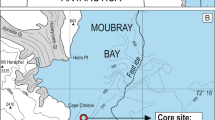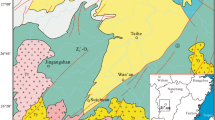Abstract
THERE are few if any investigations of deep-sea cherts or siliceous sediments from the geochemical point of view, although several geological and mineralogical studies have been published1–6. We present here data on rare-earth elements (REE) in deep-sea cherts, and compare them with relevant data on seawaters as well as cherts exposed on land.
This is a preview of subscription content, access via your institution
Access options
Subscribe to this journal
Receive 51 print issues and online access
$199.00 per year
only $3.90 per issue
Buy this article
- Purchase on Springer Link
- Instant access to full article PDF
Prices may be subject to local taxes which are calculated during checkout
Similar content being viewed by others
References
Ramsay, A. T. S. Nature 233, 115–117 (1971).
Gibson, T. G. & Towe, K. M. Science 172, 152–154 (1971).
Calvert, S. E. Contr. Mineral. Petrol. 33, 273–288 (1971).
Heath, G. R. & Moberly, R. Initial Reports of the Deep Sea Drilling Project, 7, 991–1007 (US Government Printing Office, Washington, 1971).
Keene, J. B. & Kastner, M. Nature 249, 754–755 (1974).
Keene, J. B. Initial Reports of the Deep Sea Drilling Project, 32, 429–507 (U.S. Government Printing Office, Washington, 1975).
Goldberg, E. D., Koide, M., Schmitt, R. A. & Smith, R. H. J. geophys. Res. 68, 4209–4217 (1963).
Piper, D. Z. Geochim. cosmochim. Acta 38, 1007–1022 (1974).
Masuda, A. & Nagasawa, S. Geochem. J. 9, 227–233 (1975).
Robertson, A. H. F. & Fleet, A. J. Earth planet. Sci. Lett. 28, 385–394 (1976).
Musich, L. F. A Guide to Pacific Core Material. (Scripps Institution of Oceanography, La Jolla, 1974).
Masuda, A., Nakamura, N. & Tanaka, T. Geochim. cosmochim. Acta 37, 239–248 (1973).
Wildeman, T. R. & Haskin, L. A. Geochim. cosmochim. Acta 37, 419–438 (1973).
Alexander, E. C. Precambrian Res. 2, 329–344 (1975).
Kolodny, Y. & Epstein, S. Geochim. cosmochim. Acta 40, 1195–1209 (1976).
Høgdahl, O., Semiannual Prog. Rep. No. 6, NATO Res. Grant No. 203 (1968).
Kolesov, G. M., Anikiyev, V. V. & Savenko, V. S. Geochem. Int. 12, 82–88 (1975).
Høgdahl, O. The first coordinating meeting within the IAEA Research Agreement Coordinated Programme on Marine Radioactivity Studies, Monaco, June, 1970 (unpublished).
Jones, J. B. & Segnit, E. R. J. geol. Soc. Aust. 18, 57–68 (1971).
Author information
Authors and Affiliations
Rights and permissions
About this article
Cite this article
SHIMIZU, H., MASUDA, A. Cerium in chert as an indication of marine environment of its formation. Nature 266, 346–348 (1977). https://doi.org/10.1038/266346a0
Received:
Accepted:
Issue Date:
DOI: https://doi.org/10.1038/266346a0
This article is cited by
-
Quartz types, genesis and their geological significance within the Wufeng-Longmaxi Formation in north-western Hunan, China
Frontiers of Earth Science (2023)
-
Geochemical characteristics of the Late Cretaceous radiolarian cherts from North Andaman Island, Bay of Bengal, India
Journal of Earth System Science (2020)
-
Comparative geochemical study of the cherty rocks of the Taukha terrane (Sikhote-Alin) and its paleogeodynamic significance
Acta Geochimica (2020)
-
Geochemistry of upper Permian siliceous rocks from the Lower Yangtze region, southeastern China: implications for the origin of chert and Permian ocean chemistry
Petroleum Science (2019)
-
The origin and geochemical characteristics of Permian chert in the Eastern Sichuan Basin, China
Carbonates and Evaporites (2018)
Comments
By submitting a comment you agree to abide by our Terms and Community Guidelines. If you find something abusive or that does not comply with our terms or guidelines please flag it as inappropriate.



